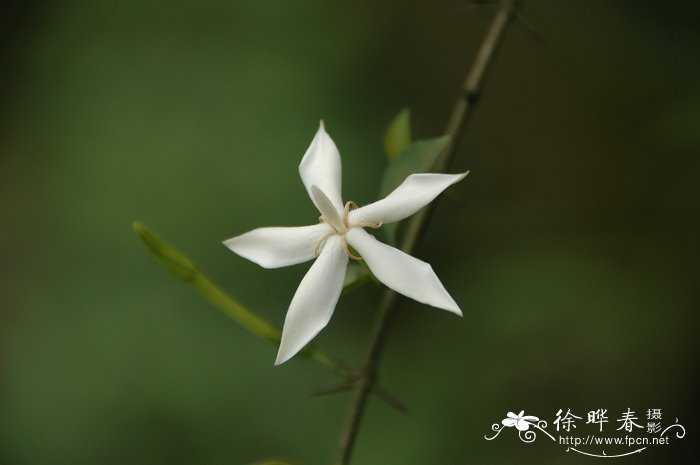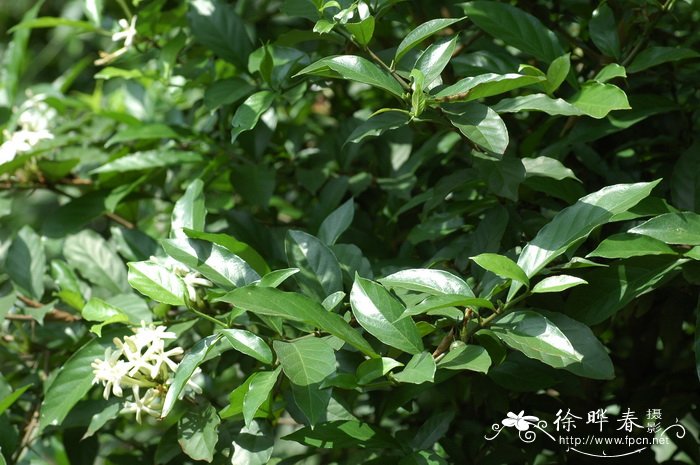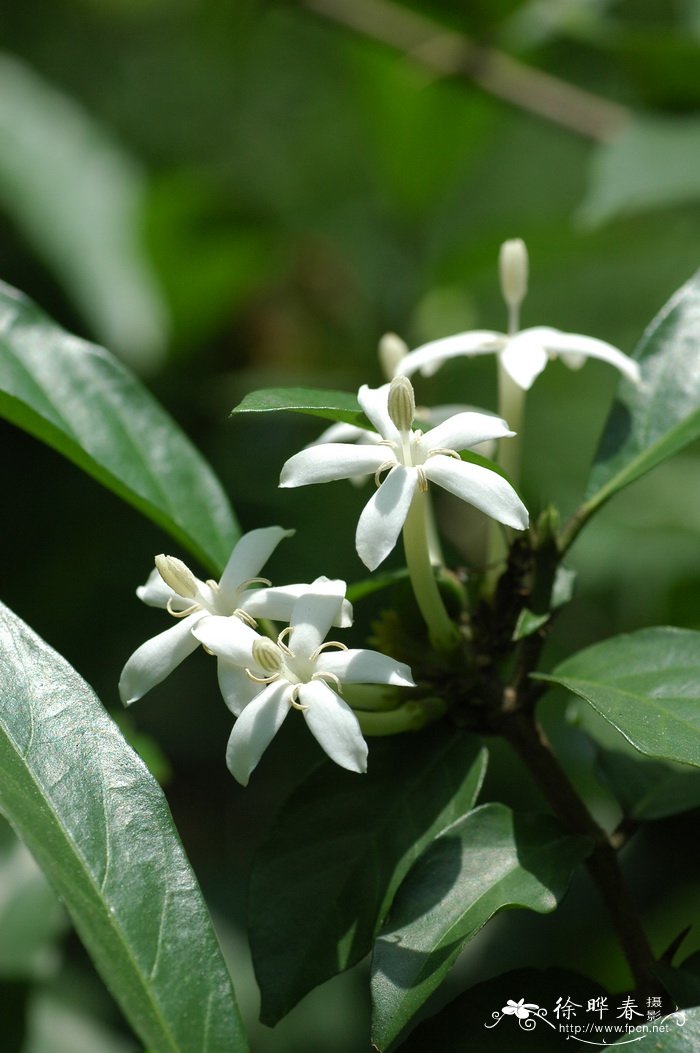猪肚木Canthium horridum
中文名(Chinese Name):猪肚木
学名(Scientific Name):Canthium horridum Blume
英文名(English Common Name):
别名(Chinese Common Name):猪肚簕
异名(Synonym):Canthium zizyphinum Wall. Hyptianthera rhamnoides Zoll. & Moritzi Dondisia horrida (Blume) Korth. Canthium horridum var. xanthocaulon (Miq.) Miq. Canthium scandens var. xanthocaulon Miq.
科属(Family & Genus):茜草科(Rubiaceae)鱼骨木属
形态特征(Description):灌木,高2-3米,具刺;小枝纤细,圆柱形,被紧贴土黄色柔毛;刺长3-30毫米,对生,劲直,锐尖。叶纸质,卵形,椭圆形或长卵形,长2-3 (-5)厘米,宽1-2厘米,顶端钝、急尖或近渐尖,基部圆或阔楔形,无毛或沿中脉略被柔毛;侧脉每边2-3条,纤细,在叶下面稍明显;叶柄短,长2-3毫米,略被柔毛;托叶长2-3毫米,被毛。花小,具短梗或无花梗,单生或数朵簇生于叶腋内;小苞片杯形,生于花梗顶部;萼管倒圆锥形,长1-1.5毫米,萼檐顶部有不明显波状小齿;花冠白色,近瓮形,冠管短,长约2毫米,外面无毛,喉部有倒生髯毛,顶部5裂,裂片长圆形,长约3毫米,顶端锐尖;花丝短,花药内藏或微突出,长约5毫米,基部被柔毛;柱头橄榄形,粗糙。核果卵形,单生或孪生,长15-25毫米,直径10-20毫米,顶部有微小宿存萼檐,内有小核1-2个;小核具不明显小瘤状体。花期4-6月。
分布(Distribution):产广东、香港、海南、广西、云南,生于低海拔的灌丛。印度、中南半岛、马来西亚、印度尼西亚、菲律宾等地也有。
用途(Use):本种木材适作雕刻;成熟果实可食;根可作利尿药用。
引自中国植物志英文版:FOC Vol. 19 Page 84, 85
Canthium horridum Blume, Catalogus. 45. 1823.
猪肚木 zhu du mu | Rubiaceae | Canthium
Canthium hebecladum Candolle; C. pauciflorum Blanco; Plectronia horrida (Blume) Bentham & J. D. Hooker.
Shrubs, 2-3 m tall; branches flattened to subterete, often rather slender, strigillose to strigose or pilosulous, sometimes with lateral short shoots to 0.5 cm; thorns slender to stout, 3-30 mm, straight, or sometimes absent. Leaves paired along developed stems or sometimes clustered on lateral short shoots; petiole 2-3 mm, strigillose to pilosulous; blade drying papery, ovate to lanceolate or elliptic, 2-6 × 1-3.5 cm, adaxially glabrous or strigillose to hispidulous along principal veins or throughout, abaxially puberulent to strigillose or hispidulous, base rounded or obtuse, apex obtuse, acute, or weakly acuminate; secondary veins 2 or 3 pairs, in abaxial axils with pilosulous and/or foveolate domatia; stipules deciduous after distalmost several nodes, triangular to ovate, 2-3 mm, densely strigillose to strigose, acute. Inflorescences fasciculate, 0.5-1 cm, few flowered, strigillose to glabrescent; peduncles 1-3 mm, each with a pair of triangular bracteoles ca. 1 mm and fused in pairs. Calyx puberulent to glabrous; ovary portion obconic, ca. 0.8 mm; limb 0.5-0.8 mm, truncate to undulate. Corolla white, funnelform, outside glabrous; tube suburceolate, ca. 2 mm; lobes 5, triangular-oblong, ca. 3 mm, acuminate. Ovary 2-locular; stigma ca. 0.5 mm. Drupes yellow, ovoid to subglobose, obovoid, or somewhat dicoccous, laterally somewhat flattened, 15-25 × 10-20 mm, smooth, glabrous, with calyx limb persistent; pyrenes 2, weakly tuberculate. Fl. Apr-Jun, fr. Jul-Nov.
Thickets at low elevations; near sea level to 500 m. Guangdong, Guangxi, Hainan, Yunnan [India, Malaysia, Thailand, Vietnam].
The name Canthium parvifolium Roxburgh has sometimes been applied to the Chinese plants that are here called C. horridum. W. C. Ko (in FRPS 71(2): 10. 1999) considered it a misapplied name, listing it as "Canthium parvifolium auct. non Roxb."



(责任编辑:徐晔春)
学名(Scientific Name):Canthium horridum Blume
英文名(English Common Name):
别名(Chinese Common Name):猪肚簕
异名(Synonym):Canthium zizyphinum Wall. Hyptianthera rhamnoides Zoll. & Moritzi Dondisia horrida (Blume) Korth. Canthium horridum var. xanthocaulon (Miq.) Miq. Canthium scandens var. xanthocaulon Miq.
科属(Family & Genus):茜草科(Rubiaceae)鱼骨木属
形态特征(Description):灌木,高2-3米,具刺;小枝纤细,圆柱形,被紧贴土黄色柔毛;刺长3-30毫米,对生,劲直,锐尖。叶纸质,卵形,椭圆形或长卵形,长2-3 (-5)厘米,宽1-2厘米,顶端钝、急尖或近渐尖,基部圆或阔楔形,无毛或沿中脉略被柔毛;侧脉每边2-3条,纤细,在叶下面稍明显;叶柄短,长2-3毫米,略被柔毛;托叶长2-3毫米,被毛。花小,具短梗或无花梗,单生或数朵簇生于叶腋内;小苞片杯形,生于花梗顶部;萼管倒圆锥形,长1-1.5毫米,萼檐顶部有不明显波状小齿;花冠白色,近瓮形,冠管短,长约2毫米,外面无毛,喉部有倒生髯毛,顶部5裂,裂片长圆形,长约3毫米,顶端锐尖;花丝短,花药内藏或微突出,长约5毫米,基部被柔毛;柱头橄榄形,粗糙。核果卵形,单生或孪生,长15-25毫米,直径10-20毫米,顶部有微小宿存萼檐,内有小核1-2个;小核具不明显小瘤状体。花期4-6月。
分布(Distribution):产广东、香港、海南、广西、云南,生于低海拔的灌丛。印度、中南半岛、马来西亚、印度尼西亚、菲律宾等地也有。
用途(Use):本种木材适作雕刻;成熟果实可食;根可作利尿药用。
引自中国植物志英文版:FOC Vol. 19 Page 84, 85
Canthium horridum Blume, Catalogus. 45. 1823.
猪肚木 zhu du mu | Rubiaceae | Canthium
Canthium hebecladum Candolle; C. pauciflorum Blanco; Plectronia horrida (Blume) Bentham & J. D. Hooker.
Shrubs, 2-3 m tall; branches flattened to subterete, often rather slender, strigillose to strigose or pilosulous, sometimes with lateral short shoots to 0.5 cm; thorns slender to stout, 3-30 mm, straight, or sometimes absent. Leaves paired along developed stems or sometimes clustered on lateral short shoots; petiole 2-3 mm, strigillose to pilosulous; blade drying papery, ovate to lanceolate or elliptic, 2-6 × 1-3.5 cm, adaxially glabrous or strigillose to hispidulous along principal veins or throughout, abaxially puberulent to strigillose or hispidulous, base rounded or obtuse, apex obtuse, acute, or weakly acuminate; secondary veins 2 or 3 pairs, in abaxial axils with pilosulous and/or foveolate domatia; stipules deciduous after distalmost several nodes, triangular to ovate, 2-3 mm, densely strigillose to strigose, acute. Inflorescences fasciculate, 0.5-1 cm, few flowered, strigillose to glabrescent; peduncles 1-3 mm, each with a pair of triangular bracteoles ca. 1 mm and fused in pairs. Calyx puberulent to glabrous; ovary portion obconic, ca. 0.8 mm; limb 0.5-0.8 mm, truncate to undulate. Corolla white, funnelform, outside glabrous; tube suburceolate, ca. 2 mm; lobes 5, triangular-oblong, ca. 3 mm, acuminate. Ovary 2-locular; stigma ca. 0.5 mm. Drupes yellow, ovoid to subglobose, obovoid, or somewhat dicoccous, laterally somewhat flattened, 15-25 × 10-20 mm, smooth, glabrous, with calyx limb persistent; pyrenes 2, weakly tuberculate. Fl. Apr-Jun, fr. Jul-Nov.
Thickets at low elevations; near sea level to 500 m. Guangdong, Guangxi, Hainan, Yunnan [India, Malaysia, Thailand, Vietnam].
The name Canthium parvifolium Roxburgh has sometimes been applied to the Chinese plants that are here called C. horridum. W. C. Ko (in FRPS 71(2): 10. 1999) considered it a misapplied name, listing it as "Canthium parvifolium auct. non Roxb."
(责任编辑:徐晔春)
踩一下[1]

顶一下[4]